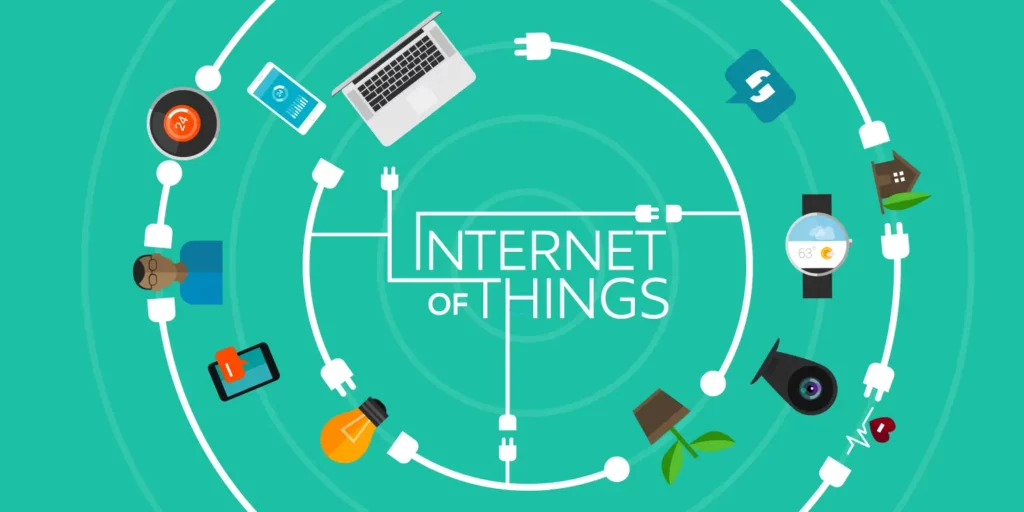
As our homes and workplaces get smarter, security worries are on the rise. We’re connecting more devices to the internet than ever before, forming an expansive web of ‘smart’ technology.
This blog will shed light on how to protect your personal data and gadgets in this ever-growing Internet of Things. Dive in for a safer digital future!
Key Takeaways
- Internet of Things devices can be vulnerable due to weak or default credentials, creating security risks including unauthorised access and data breaches. It’s critical to strengthen authentication methods and regularly monitor these devices.
- Hackers can use compromised Internet of Things devices for botnets and DDoS attacks, leading to significant disruptions. Implementing robust cybersecurity strategies is key to preventing such malicious activities.
- The physical safety of users can be jeopardised if IoT devices are tampered with; hence stringent security measures are necessary, especially in smart home systems and connected medical equipment.
- Complying with cross – border data transfer regulations helps protect privacy rights and maintain trust. This compliance is increasingly important as the global reach of Internet of Things expands.
- Advancements in AI and blockchain technologies are enhancing the security within the IoT landscape by detecting anomalies promptly and securing data exchange effectively.
What is Internet of Things?
It’s a network where everyday objects, like fridges, watches, and thermostats, connect to the internet to exchange data and automate tasks without human intervention.
These connected devices can be controlled from afar and can gather information that helps improve our daily lives. For example, your smart thermostat learns your schedule to save energy when you’re away from home.
Its growth is reshaping how we interact with technology in our homes and workplaces. Everything from kitchen appliances to security systems is becoming smarter and more interconnected.
This evolution creates convenience but also presents new challenges for protecting sensitive data and ensuring these smart devices are safe against cyber threats.
Security Risks
Internet of Things poses significant security risks, including data privacy concerns, vulnerabilities in devices, botnets and DDoS attacks, and even potential physical safety risks. These threats highlight the importance of addressing cybersecurity challenges within its ecosystem.
Data Privacy Concerns
Data privacy concerns arise from the vast amount of personal information collected and shared by IoT devices. With the increased connectivity, there are heightened risks of unauthorised access to sensitive data such as location, health records, and daily routines.
Weak authentication methods and inadequate security measures expose this data to potential breaches, putting user privacy at risk. The growing use of IoT in various environments necessitates robust security protocols to protect individuals’ personal information.
As Internet of Things becomes more prevalent in our daily lives, it’s crucial for users to be aware of their data privacy rights and take necessary precautions when using connected devices. This includes being mindful of the data these devices collect and understanding how it is used or shared.
By staying informed about their data privacy settings and implementing strong security measures, individuals can mitigate potential risks associated with the devices.
Vulnerabilities in Internet of Things Devices
Internet of Things devices often have weak or default credentials, making them susceptible to unauthorised access. Hackers can exploit this vulnerability to gain control over these devices. As a result, security professionals are increasingly concerned about the risk of data privacy breaches and unauthorised access.
Weak authentication and authorisation in IoT devices are common security issues that need to be addressed as its ecosystem continues to grow rapidly. It’s crucial for users and organisations alike to prioritise implementing recognised security practices and monitoring these devices closely.
The escalated growth of IoT has increased the attack surface that hackers can potentially exploit, according to cybersecurity professionals. Given this scenario, it is imperative that individuals and businesses take proactive steps such as designing robust security measures, authenticating access effectively, and ensuring secure data management across all the devices they use or deploy.

Botnets and DDoS Attacks
Botnets and DDoS attacks pose significant threats to IoT security. Hackers can compromise multiple devices, forming botnets to launch large-scale DDoS attacks. These attacks can overwhelm networks and cause widespread service disruptions, impacting both businesses and individuals.
Security measures such as strong authentication methods and regular monitoring are crucial in safeguarding against these malicious activities. Additionally, organisations should implement strategies to detect and neutralise botnet activity swiftly, mitigating potential harm caused by DDoS attacks.
Cybersecurity professionals emphasise the importance of addressing vulnerabilities in IoT devices to prevent them from being exploited for botnet formation or targeted in DDoS assaults.
Physical Safety Risks
Many Internet of Things devices, such as smart home security systems and connected medical devices, pose physical safety risks if compromised. Ones do not meet regulatory standards may malfunction or be susceptible to cyber-attacks, potentially endangering individuals’ safety.
For instance, in a worst-case scenario, unauthorised access could lead to tampering with critical medical equipment or the manipulation of smart home appliances that impact personal safety.
The vulnerability of IoT devices can put people at risk in unexpected ways; for example, attackers might exploit weaknesses in connected car systems to take control of vehicles remotely.
Impact of Internet of Things on Cybersecurity
Internet of Things presents challenges in securing devices and ensuring compliance with cross-border data transfer regulations, highlighting the need for advancements in AI and blockchain technology to enhance IoT security.
Challenges With Securing Internet of Things Devices
Securing IoT devices presents numerous challenges for users and organisations. Weak or default credentials on many devices make them vulnerable to unauthorised access, constituting a significant security risk.
Moreover, the diverse nature of Internet of Things ecosystems also leads to a wide array of vulnerabilities that can be exploited by cybercriminals. This is compounded by the fact that weak authentication and authorisation are common security issues, posing an ongoing threat to data privacy and network security.
Furthermore, as the escalating growth of Internet of Things continues to reform our lives with internet-connected devices, it increases the attack surface available for hackers to exploit. The increased risk for information security and privacy with the Internet of Things has become a critical consideration for both individuals and businesses alike.
Importance of Cross-Border Data Transfer Compliance
Cross-border data transfer compliance is critical for ensuring the security and privacy of personal information. Organisations need to adhere to regulations and standards when transferring data across different countries or regions.
This helps in safeguarding sensitive information from unauthorised access, protecting individuals’ privacy rights, and maintaining trust with customers and partners.
Compliance with cross-border data transfer regulations also minimises the risk of legal repercussions and financial penalties. As the Internet of Things continues to expand globally, understanding and adhering to these compliance requirements becomes increasingly important for businesses, especially those operating on an international scale.
By prioritising cross-border data transfer compliance, organisations can build a secure foundation that supports responsible data management practices while enabling innovation and growth in the IoT landscape.
Role of AI and Blockchain in Securing Internet of Things

AI and blockchain play a crucial role in enhancing the security of IoT devices. AI algorithms can identify unusual behavior patterns and potential security threats within its ecosystem, enabling swift responses to mitigate risks.
Blockchain technology offers tamper-proof data storage, ensuring the integrity of information exchanged across Internet-connected devices and enhancing cybersecurity in its landscape.
Implementing AI-driven anomaly detection and blockchain-based secure data exchange addresses critical factors for adoption in securing IoT devices against evolving cyber threats. These cutting-edge technologies contribute to safeguarding sensitive information, promoting trust in smart technology, and fortifying digital security within its expanding realm.
Mitigating Security Risks
Addressing critical factors for adoption and implementing collective decision-making are essential in mitigating the security risks associated with IoT. It’s important to ensure proper adoption of security measures to safeguard against potential threats.
Addressing Critical Factors for Adoption
To address critical factors for adoption, it is important to consider the following:
- Implement strong authentication and authorisation measures to prevent unauthorised access to Internet of Things devices.
- Ensure that the devices have robust security features such as encryption and secure data management to protect sensitive information.
- Regularly update and patch IoT devices to mitigate vulnerabilities and enhance overall security.
- Educate users about best practices for using devices and the potential security risks associated with them.
- Collaborate with industry experts and regulatory bodies to establish standards and guidelines for secure its adoption.
- Foster a culture of proactive cybersecurity awareness and responsibility among individuals and organisations using Internet of Things devices.
Implementing Collective Decision-Making

To address critical factors for adoption, implementing collective decision-making is crucial in ensuring the security of IoT devices. This involves fostering collaboration among various stakeholders, including manufacturers, government bodies, cybersecurity experts, and end-users.
By collectively making decisions about IoT security standards and best practices, the industry can work towards establishing a unified approach to mitigating security risks across its ecosystem.
Moreover, involving diverse perspectives in decision-making processes can lead to more comprehensive and effective solutions. It enables the identification of potential vulnerabilities from different angles and promotes a holistic understanding of security requirements within its landscape.
Ensuring Proper Adoption of Security Measures
- Use strong and unique passwords: Many devices come with default or weak passwords, making them vulnerable to unauthorised access.
- Regularly update firmware: Manufacturers often release updates to fix security vulnerabilities in their devices, so keeping firmware up to date is crucial.
- Encrypt data transmission: Enable encryption on all devices to protect the data they transmit over wireless networks.
- Implement multi-factor authentication: Adding an extra layer of security can help prevent unauthorised access even if passwords are compromised.
- Conduct regular security audits: Regularly assess the security of devices and systems to identify and address any weaknesses or vulnerabilities.
- Educate users about security best practices: User awareness and knowledge of security measures can significantly contribute to overall security.
- Monitor network traffic: Keeping an eye on network traffic can help detect any suspicious activity and potential security breaches.
Mitigating Internet of Things security risks requires addressing critical factors for adoption and implementing collective decision-making. Ensuring proper adoption of security measures is crucial in safeguarding the Internet-connected devices whilst navigating the complex landscape of its cybersecurity.
The escalated growth of IoT has started to reform and reshape our lives, emphasising the urgency of prioritising robust security measures. As it continues to evolve and expand, it’s vital to recognise and confront the pivotal role that effective security practices play in protecting personal data and ensuring a safe digital environment for all users.
